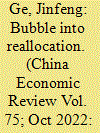| Srl | Item |
| 1 |
ID:
187889


|
|
|
|
|
| Summary/Abstract |
This paper develops a theoretical framework to shed lights on the relations between the segmented financial market and the housing bubble in China. In our framework, capital misallocation across firms plays a central role. The segmented financial market causes discrimination against private enterprises and favoritism to state-owned firms. This biased financial system not only gives rise to capital misallocation across firms but also significantly pushes down the equilibrium interest rate in the formal financial market. The overly low interest rate in the formal financial market causes a rational bubble in a dynamically efficient economy. More importantly, the bubble improves capital allocation across firms by crowding out inefficient investment in the state-owned sector. Despite the role of improving capital allocation, bubbles may still reduce welfare by crowding out aggregate capital.
|
|
|
|
|
|
|
|
|
|
|
|
|
|
|
|
| 2 |
ID:
167815


|
|
|
|
|
| Summary/Abstract |
Cross‐country comparison reveals an unusually small service sector in China. Using firm‐level data from China's 2008 economic census, we find two facts that speak to a novel mechanism of misallocation within service and between manufacturing and service sectors. First, compared with the manufacturing sector, there are more state‐owned enterprises and fewer entrants in the service sector. Second, markups increase with firm size, and the increase is more dramatic among service firms. We interpret these facts through the lens of a monopolistic competition model with heterogeneous firms and variable markups. A multisector model shows a new channel that translates asymmetric barriers to entry across sectors into sectoral markup differences, which in turn cause sectoral misallocation. Quantitative analysis shows that when reducing entry barriers to service firms to the extent observed for manufacturing firms, the model predicts a 12‐percentage‐point increase in the service employment share.
|
|
|
|
|
|
|
|
|
|
|
|
|
|
|
|